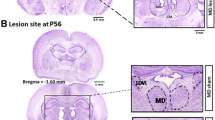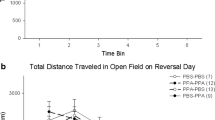Summary
The ability of intrahippocampal grafts of fetal septal-diagonal band tissue, rich in developing cholinergic neurons, to ameliorate cognitive impairments induced by bilateral fimbria-fornix transections in rats was examined in three experiments using the Morris water-maze to test different aspects of spatial memory. Experiment 1. Rats with fimbria-fornix lesions received either septal cell suspension grafts or solid septal grafts; normal rats and rats with lesions alone were used as controls. Sixteen weeks after surgery, the rats' spatial learning and memory were tested in the water-maze using a place test, designed to investigate place navigation performance, in which rats learned to escape from the water by swimming to a platform hidden beneath the water's surface. After 5 days of training, the rats were given a spatial probe test in which the platform was removed from the tank to test spatial reference memory. Experiment 2. The same rats used in Exp. 1 were tested in a delayed-match-to-sample, working memory version of the water-maze task. The platform was located in one of two possible locations during each trial, which was composed of 2 swims. If the rat remembered the location of the platform on the 2nd swim of a trial, it should find the platform more quickly on that swim, and thereby demonstrate working memory. Experiment 3. Prior to receiving fimbria-fornix lesions, normal rats were trained in a modification of the water-maze task using alternating cue navigation and place navigation trials (i.e., with visible or non-visible escape platforms). The retention and reacquisition of the place task and the spatial probe test were examined in repeated tests up to 6 months after the lesion and intrahippocampal grafting of septal cell suspensions. The effects of central muscarinic cholinergic receptor blockade with atropine were also tested. Normal rats performed well in both the place and spatial probe tests. In contrast, rats with fimbria-fornix lesions only were unable to acquire or retain spatial information in any test. Instead, these rats adopted a random, nonspatial search strategy, whereby their latencies to find the platform decreased in the place navigation tasks. Sixty to 80% of the rats with septal suspension or solid grafts had recovered place navigation, i.e., the ability to locate the platform site in the tank, in Exp. 1 and 3, and they showed a significantly improved performance in the working memory test in Exp. 2. Atropine abolished the recovered place navigation in the grafted rats, whereas normal rats were impaired to a lesser extent. In contrast, atropine had no effect on the non-spatial strategy adopted by rats with fimbria-fornix lesions only. The results show that: (1) fimbria-fornix lesions disrupt spatial learning and memory in both naive and pretrained rats; (2) with extended training the fimbria-fornix lesioned rats develop an efficient non-spatial strategy, which enables them to reduce their escape latency to levels close to those of intact controls; (3) intrahippocampal septal grafts can restore the ability of the lesioned rats to use spatial cues in the localization of the platform site; and (4) the behavioural recovery produced by grafts is dependent upon an atropine sensitive mechanism.
Similar content being viewed by others
References
Anderson KJ, Gibbs RB, Salvaterra PM, Cotman CW (1986) Ultrastructural characterization of identified cholinergic neurons transplanted to the hippocampal formation of the rat. J Comp Neurol 249: 279–292
Björklund A, Stenevi U (1977) Reformation of the severed septohippocampal cholinergic pathway in the rat by transplanted septal neurons. Cell Tiss Res 185: 289–302
Björklund A, Gage FH, Stenevi U, Dunnett SB (1983a) Intracerebral grafting of neuronal cell suspensions. VI. Survival and growth of intrahippocampal implants of septal cell suspensions. Acta Physiol Scand Suppl 522: 49–58
Björklund A, Stenevi U, Schmidt RH, Dunnett SB, Gage FH (1983b) Intracerebral grafting of neuronal cell suspensions. I. Introduction and general methods of preparation. Acta Physiol Scand Suppl 522: 1–7
Björklund A, Gage FH, Schmidt RH, Stenevi U, Dunnett SB (1983c) Intracerebral grafting of neuronal cell suspensions. VII. Recovery of choline acetyltransferase activity and acetylcholine synthesis in the denervated hippocampus reinnervated by septal suspension implants. Acta Physiol Scand Suppl 522: 59–66
Buzsaki G, Gage FH, Czopf I, Björklund A (1987) Restoration of rhythmic slow activity (theta) in the subcortically denervated hippocampus by fetal CNS transplants. Brain Res 400: 334–347
Clarke DJ, Gage FH, Björklund A (1986) Formation of synapses by intrahippocampal grafts as revealed by choline acetyltransferase immunocytochemistry. Brain Res 369: 151–162
Daniloff JK, Bodony RP, Low WC, Wells J (1985) Cross-species embryonic septal transplants: restoration of conditioned learning behaviour. Brain Res 346: 176–180
Dunnett SB, Low WC, Iversen SD, Stenevi U, Björklund A (1982) Septal transplants restore maze learning in rats with fornix-fimbria lesions. Brain Res 251: 335–348
Gage FH, Björklund A, Stenevi U, Dunnett SB, Kelly PAT (1984) Intrahippocampal septal grafts ameliorate learning impairments in aged rats. Science 225: 533–535
Gage FH, Buzsaki G, Nilsson OG, Björklund A (1987) Grafts of fetal cholinergic neurons to the deafferented hippocampus. Prog Brain Res (in press)
Geneser-Jensen FA, Blackstad TW (1971) Distribution of acetylcholinesterase in the hippocampal region of the guinea pig. Z Zellforsch 114: 460–481
Holmstedt B (1957) A modification of the thiocholine method for the determination of cholinesterase. Acta Physiol Scand 40: 331–357
Honig WK (1978) Studies of working memory in the pigeon. In: Hulse SH, Fowler H, Honig WK (eds) Cognitive processes in animal behaviour. Hillsdale, Erlbaum, pp 211–248
Kelly PAT, Gage FH, Ingvar M, Lindvall O, Stenevi U, Björklund A (1985) Functional reactivation of the deafferented hippocampus by embryonic septal grafts as assessed by measurements of local glucose utilization. Exp Brain Res 58: 570–579
Krnjević K, Ropert N (1982) Electrophysiological and pharmacological characteristics of facilitation of hippocampal population spikes by stimulation of the medial septum. Neuroscience 7: 2165–2183
Low WC, Lewis PR, Bunch ST, Dunnett SB, Thomas SR, Iversen SD, Björklund A, Stenevi U (1982) Functional recovery following neural transplantation of embryonic septal nuclei in adult rats with septohippocampal lesions. Nature 300: 260–262
Morris RGM (1981) Spatial localization does not require the presence of local cues. Learn Motiv 12: 239–260
Morris RGM (1983) An attempt to dissociate “spatial mapping” and “working memory” theories of hippocampal function. In: Seifert W (ed) The neurobiology of the hippocampus. Academic Press, London, pp 405–432
Morris RGM (1984) Developments of a water-maze procedure for studying spatial learning in the rat. J Neurosci Meth 11: 47–60
Morris RGM, Garrud P, Rawlins JNP, O'Keefe J (1982) Place navigation impaired in rats with hippocampal lesions. Nature 297: 681–683
Nicoll RA (1985) The septo-hippocampal projection: a model cholinergic pathway. Trends Neurosci 8: 533–536
O'Keefe J, Nadel L (1978) The hippocampus as a cognitive map. Clarendon Press, Oxford
Olton DS (1979) Mazes, maps, and memory. Am Psycholog 34: 583–596
Olton DS (1983) Memory functions of the hippocampus. In: Seifert W (ed) The neurobiology of the hippocampus. Academic Press, London, pp 335–374
Olton DS, Becker JT, Handelman GE (1979) Hippocampus, space and memory. Behav Brain Sci 2: 313–365
Pallage V, Toniolo G, Will B, Hefti F (1986) Long-term effects of nerve growth factor and neural transplants on behaviour of rats with medial septal lesions. Brain Res 386: 197–208
Rawlins JNP (1985) Associations across time: the hippocampus as a temporary memory store. Behav Brain Sci 8: 479–497
Rescorla RA, Wagner AR (1972) A theory of Pavlovian conditioning: variations in the effectiveness of reinforcement and non-reinforcement. In: Black AH, Prokasy WF (eds) Classical conditioning II. Appleton-Century-Crofts Inc, New York
Schenk F, Morris RGM (1985) Dissociation between components of spatial memory in rats after recovery from the effects of retrohippocampal lesions. Exp Brain Res 58: 11–28
Segal M, Björklund A, Gage FH (1985) Transplanted septal neurons make viable cholinergic synapses with a host hippocampus. Brain Res 336: 302–307
Segal M, Greenberger V, Milgram NW (1987) A functional analysis of connections between grafted septal nuclei and a host hippocampus. Prog Brain Res (in press)
Stenevi U, Björklund A, Svendgaard N-Aa (1976) Transplanta tion of central and peripheral mono-amine neurons to the adult rat brain: techniques and conditions for survival. Brain Res 114: 1–20
Sutherland NS, Mackintosh NJ (1971) Mechanisms of animal discrimination learning. Academic Press, New York
Sutherland RJ, Kolb B, Whishaw IQ (1982a) Spatial mapping: definitive disruption by hippocampal or medial frontal cortical damage in the rat. Neurosci Lett 31: 271–276
Sutherland RJ, Whishaw IQ, Regehr JC (1982b) Cholinergic receptor blockade impairs spatial localization using distal cues. J Comp Physiol Psychol 96: 563–573
Whishaw IQ (1985) Cholinergic receptor blockade impairs locale but not taxon strategies for place navigation in a swimming pool. Behav Neurosci 99: 979–1005
Whishaw IQ, O'Connor WT, Dunnett SB (1985) Disruption of central cholinergic systems in the rat by basal forebrain lesion or atropine: effects on feeding, sensorimotor behaviour, locomotor activity, and spatial navigation. Behav Brain Res 17: 103–115
Author information
Authors and Affiliations
Rights and permissions
About this article
Cite this article
Nilsson, O.G., Shapiro, M.L., Gage, F.H. et al. Spatial learning and memory following fimbria-fornix transection and grafting of fetal septal neurons to the hippocampus. Exp Brain Res 67, 195–215 (1987). https://doi.org/10.1007/BF00269466
Received:
Accepted:
Issue Date:
DOI: https://doi.org/10.1007/BF00269466




